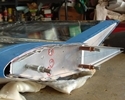

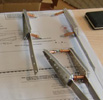
random user submitted photo
Wes's Onex #89
Re: Wes's Onex #89 (Small world)
Hi Guys,
Got in another 45 min. flight yesterday. I intended to get some serious pattern work in. After the third landing I noticed some oil on the right side of the canopy. The right valve cover gasket was cut again :-( Since my engine has close to 10 hours on it I decided to go ahead and change the oil, torque the heads, set the valve lash, and change the gasket. In the middle of the the process I realized I had left the gaskets at home, I didn't have any anti-seize, I forgot the adapter for the torque wrench, ... So I'm back home for supplies. I also ordered the gasket that Chris suggested earlier. Maybe that will be the end of that :-)
While I was working someone said "Hello, anybody home?". A couple came in and we started talking about the Onex. After a few minutes the lady showed me a pic of the gentleman's airplane. Lo and behold it was Kenneth Hollrah, owner and pilot of SubSonex 0008. I'm sorry, I forgot the lady's name (Dee?). Anyway, what a delightful couple. We talked for a good hour before they headed back to Oklahoma. They were just out cruising looking for historic airports on a beautiful Saturday morning.
There I was at KONY, the loneliest airport in the world, and ...
Wes
Got in another 45 min. flight yesterday. I intended to get some serious pattern work in. After the third landing I noticed some oil on the right side of the canopy. The right valve cover gasket was cut again :-( Since my engine has close to 10 hours on it I decided to go ahead and change the oil, torque the heads, set the valve lash, and change the gasket. In the middle of the the process I realized I had left the gaskets at home, I didn't have any anti-seize, I forgot the adapter for the torque wrench, ... So I'm back home for supplies. I also ordered the gasket that Chris suggested earlier. Maybe that will be the end of that :-)
While I was working someone said "Hello, anybody home?". A couple came in and we started talking about the Onex. After a few minutes the lady showed me a pic of the gentleman's airplane. Lo and behold it was Kenneth Hollrah, owner and pilot of SubSonex 0008. I'm sorry, I forgot the lady's name (Dee?). Anyway, what a delightful couple. We talked for a good hour before they headed back to Oklahoma. They were just out cruising looking for historic airports on a beautiful Saturday morning.
There I was at KONY, the loneliest airport in the world, and ...
Wes
Wes Ragle
Onex #89
Conventional Gear
Long Tips
Hummel 2400 w/Zenith Carb
Prince P Tip 54x50
First Flight 06/23/2020
42.8 Hrs. as of 10/30/21
Onex #89
Conventional Gear
Long Tips
Hummel 2400 w/Zenith Carb
Prince P Tip 54x50
First Flight 06/23/2020
42.8 Hrs. as of 10/30/21
- WesRagle
- Posts: 899
- Joined: Fri Jan 05, 2018 12:35 pm
- Location: Weatherford, Tx
Re: Wes's Onex #89
Ken and Dee are both pilots, and top-notch people as well. It's amazing how interconnected we all are in aviation. Like you said - small world!
Jeff
Jeff
- sonex1374
- Posts: 605
- Joined: Thu Mar 27, 2014 1:02 am
Re: Wes's Onex #89
The oil scoop and edging.
glen
glen
Dr. Glen Bradley
Pilot for Thatcher Aircraft Inc.
Owns a CX5, flies the CX7 and a ONEX (recently completed)
Pilot for Thatcher Aircraft Inc.
Owns a CX5, flies the CX7 and a ONEX (recently completed)
- flyingbear
- Posts: 54
- Joined: Wed Nov 27, 2019 10:19 pm
Re: Wes's Onex #89 (Rookie Mistake)
HI Guys,
Well, I made it back to KONY yesterday to finish the 10 hour maintenance on the Hummel. While pulling the right valve cover I was puzzling over why I keep cutting gaskets. Most of the forward edge of the gasket was outside. Just kinda hanging there. I pulled the cover and when it puked the residual oil I heard a "tick".
This is what it was:
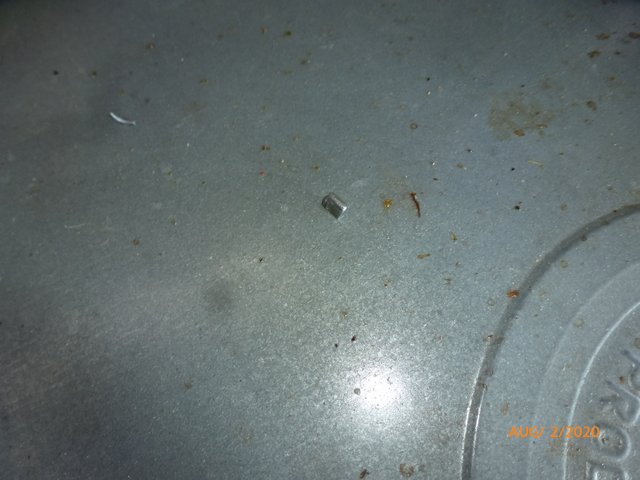
See that little square piece of metal?
Here is where it is supposed to be:
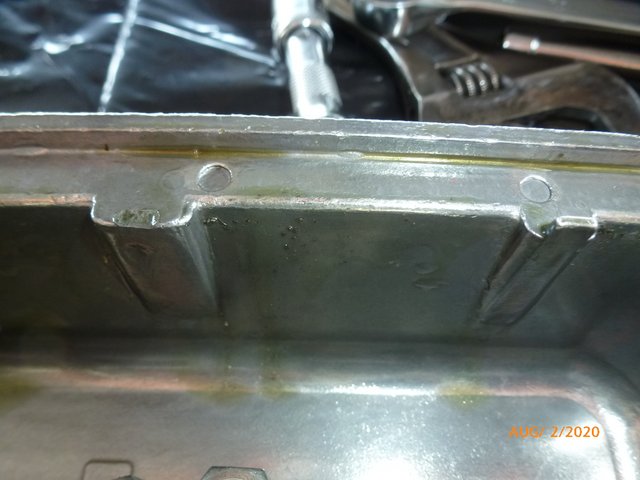
Seems that all this time I have been careless while replacing the covers and havn't centered them properly. I don't think I'll have any more problems now. The silicon gaskets have been ordered and I'll try those next oil change but I don't think they are necessary if the covers are installed properly.
Took a short test flight and the valve covers are sealed. However there is a small leak at the sump :-( I'll give that some special attention next oil change.
Went up for a second flight and got four more landings including a couple of touch and gos.
Forever Forward,
Wes
Well, I made it back to KONY yesterday to finish the 10 hour maintenance on the Hummel. While pulling the right valve cover I was puzzling over why I keep cutting gaskets. Most of the forward edge of the gasket was outside. Just kinda hanging there. I pulled the cover and when it puked the residual oil I heard a "tick".
This is what it was:

See that little square piece of metal?
Here is where it is supposed to be:

Seems that all this time I have been careless while replacing the covers and havn't centered them properly. I don't think I'll have any more problems now. The silicon gaskets have been ordered and I'll try those next oil change but I don't think they are necessary if the covers are installed properly.
Took a short test flight and the valve covers are sealed. However there is a small leak at the sump :-( I'll give that some special attention next oil change.
Went up for a second flight and got four more landings including a couple of touch and gos.
Forever Forward,
Wes
Wes Ragle
Onex #89
Conventional Gear
Long Tips
Hummel 2400 w/Zenith Carb
Prince P Tip 54x50
First Flight 06/23/2020
42.8 Hrs. as of 10/30/21
Onex #89
Conventional Gear
Long Tips
Hummel 2400 w/Zenith Carb
Prince P Tip 54x50
First Flight 06/23/2020
42.8 Hrs. as of 10/30/21
- WesRagle
- Posts: 899
- Joined: Fri Jan 05, 2018 12:35 pm
- Location: Weatherford, Tx
Re: Wes's Onex #89 (Update)
Hi Guys,
It's been a while since I've posted so ...
I updated my log book and it now shows 15.4 Hrs. and 93 landings on the Onex. At first I was chronically low (and fast) on landings. Then I was chronically high (and fast) on landings. The last couple of outings I've done better. I'm sure my technique will evolve but right now I'm flying 100 mph abeam the numbers where I slowly pulling throttle to idle. I'm holding altitude until airspeed bleeds to 80, adding 1/2 flaps and trimming for 70. I make the turn(s) and when lined up on final, if I've judged the wind correctly, add full flaps. If I'm a little low I just land with half flaps. Seventy mph isn't at all threatening and leaves some energy to make adjustments if the round out and flare aren't perfect. I hope to get a little slower on short final as I get more experience.
I've made some minor adjustments to the instrument panel.

I installed a slip/skid indicator and removed the travel trailer level I was using for trimming purposes. My instructor tells me to use my butt to verify coordinated flight. Well, my butt is due for re-calibration. The "ball" gives me more confidence during slow flight. I also removed the level and replaced it with an inexpensive OAT gauge in preparation for gathering some flight data.
I have temporary trim tabs attached to compensate for a heavy left wing and left rudder during cruise. I don't know what the final answer will be but right now I'll just leave the tabs on and enjoy the fall flying season.
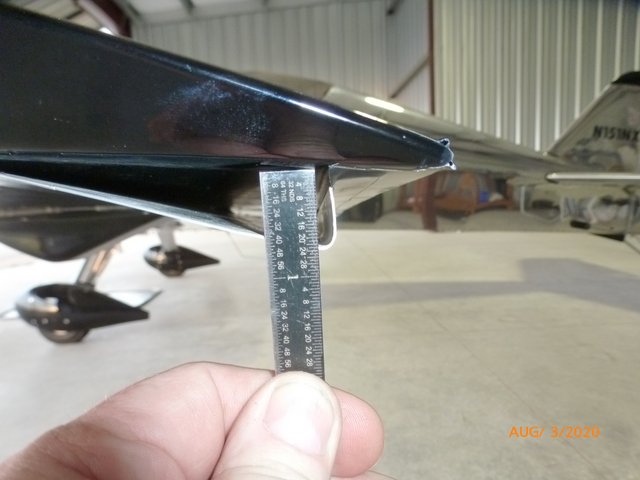
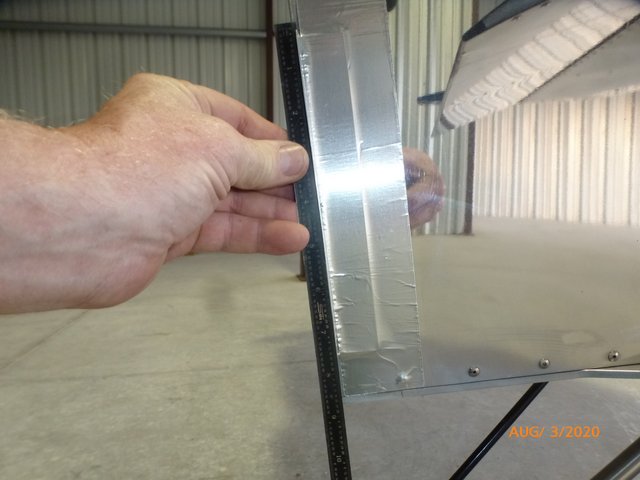
I'm still working on coordination during touch and gos. The flap handle on the Onex is farther back than I'm used to and so a little more awkward to operate. It's not hard to pull, it's just hard to pull without transferring a wiggle to the rudder peddles. When I made the flap detent angle I left a tit to make sure the handle didn't jump out of place.
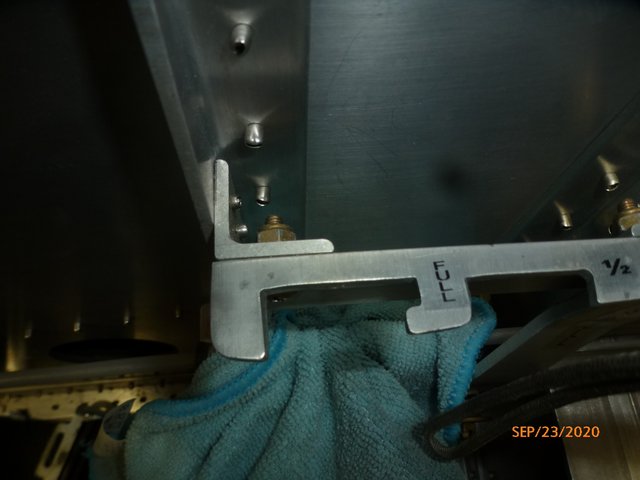
The flap handle is spring loaded and the "tit" isn't necessary and makes it harder to smoothly dump flaps on a touch and go. So, the tit is no more.
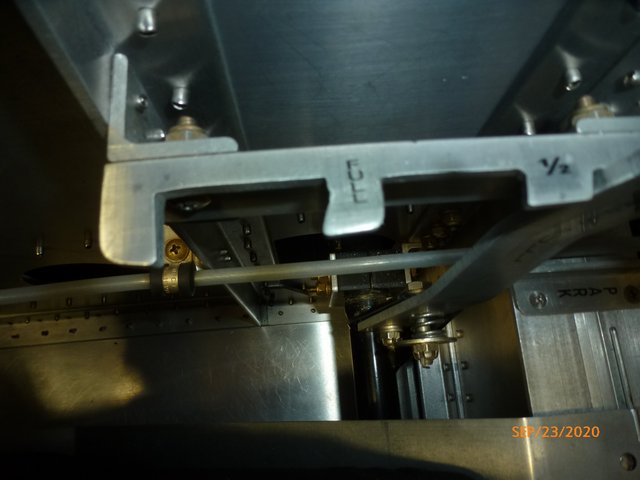
Much better.
I got tired of not being able to see the center line during takeoff and landing flare. So, I replaced the metal fuel cover with a lexan one. The view through the cover is distorted but it's easy to use it as a sight. The goal is to keep the center line of the runway in the fuel cover :-)
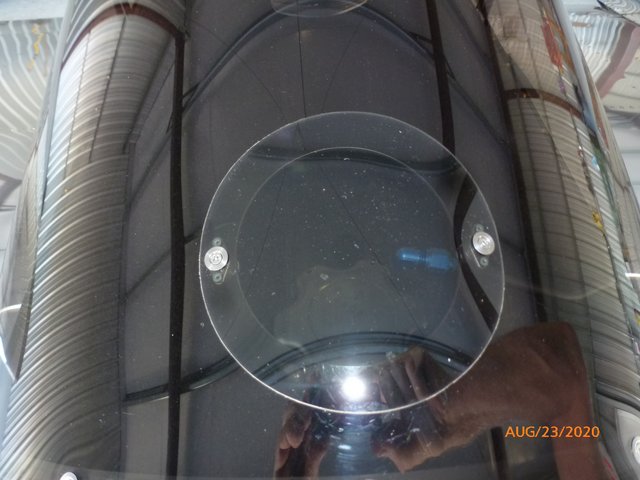
The engine is running great except for one thing. Ever since first flight the right rear cylinder has run hotter in both EGT and CHT than the other cylinders. With the modifications I made to the cowling outlet the CHT never approaches the 400 Deg. F. limit, it's just 30 deg. hotter than the others. EGT is the problem. During climb out after a takeoff I have to throttle back to 3200 RPM to keep the EGT below 1350 Deg. F. That still leaves me climbing at 700 fpm, but full throttle easily gives me 1000 fpm and that's fun :-) I could just start enriching the mixture but the cruise performance is so good I hate to take that approach. Maybe I have no choice. We'll see. I need to figure this one out.
With OAT of 70, at 3000 RPM cruise, Oil Temp is down to 180 F, hottest CHT is 317 and EGTs are down in the mid to low 1200s. I'm running 100 LL with TCP.
The only airframe mystery is why, pray tell, do I have to pump the hydraulic brakes up after a flight. They are fine at the hangar, they are fine at the run up area, but after landing I have to pump them before they hold. Very odd.
Anyway, I'm enjoying the Onex more each time out.
Oh yea, the Carter Copter is back at KONY for flight testing. Pretty cool.

Wes
It's been a while since I've posted so ...
I updated my log book and it now shows 15.4 Hrs. and 93 landings on the Onex. At first I was chronically low (and fast) on landings. Then I was chronically high (and fast) on landings. The last couple of outings I've done better. I'm sure my technique will evolve but right now I'm flying 100 mph abeam the numbers where I slowly pulling throttle to idle. I'm holding altitude until airspeed bleeds to 80, adding 1/2 flaps and trimming for 70. I make the turn(s) and when lined up on final, if I've judged the wind correctly, add full flaps. If I'm a little low I just land with half flaps. Seventy mph isn't at all threatening and leaves some energy to make adjustments if the round out and flare aren't perfect. I hope to get a little slower on short final as I get more experience.
I've made some minor adjustments to the instrument panel.

I installed a slip/skid indicator and removed the travel trailer level I was using for trimming purposes. My instructor tells me to use my butt to verify coordinated flight. Well, my butt is due for re-calibration. The "ball" gives me more confidence during slow flight. I also removed the level and replaced it with an inexpensive OAT gauge in preparation for gathering some flight data.
I have temporary trim tabs attached to compensate for a heavy left wing and left rudder during cruise. I don't know what the final answer will be but right now I'll just leave the tabs on and enjoy the fall flying season.


I'm still working on coordination during touch and gos. The flap handle on the Onex is farther back than I'm used to and so a little more awkward to operate. It's not hard to pull, it's just hard to pull without transferring a wiggle to the rudder peddles. When I made the flap detent angle I left a tit to make sure the handle didn't jump out of place.

The flap handle is spring loaded and the "tit" isn't necessary and makes it harder to smoothly dump flaps on a touch and go. So, the tit is no more.

Much better.
I got tired of not being able to see the center line during takeoff and landing flare. So, I replaced the metal fuel cover with a lexan one. The view through the cover is distorted but it's easy to use it as a sight. The goal is to keep the center line of the runway in the fuel cover :-)

The engine is running great except for one thing. Ever since first flight the right rear cylinder has run hotter in both EGT and CHT than the other cylinders. With the modifications I made to the cowling outlet the CHT never approaches the 400 Deg. F. limit, it's just 30 deg. hotter than the others. EGT is the problem. During climb out after a takeoff I have to throttle back to 3200 RPM to keep the EGT below 1350 Deg. F. That still leaves me climbing at 700 fpm, but full throttle easily gives me 1000 fpm and that's fun :-) I could just start enriching the mixture but the cruise performance is so good I hate to take that approach. Maybe I have no choice. We'll see. I need to figure this one out.
With OAT of 70, at 3000 RPM cruise, Oil Temp is down to 180 F, hottest CHT is 317 and EGTs are down in the mid to low 1200s. I'm running 100 LL with TCP.
The only airframe mystery is why, pray tell, do I have to pump the hydraulic brakes up after a flight. They are fine at the hangar, they are fine at the run up area, but after landing I have to pump them before they hold. Very odd.
Anyway, I'm enjoying the Onex more each time out.
Oh yea, the Carter Copter is back at KONY for flight testing. Pretty cool.

Wes
Wes Ragle
Onex #89
Conventional Gear
Long Tips
Hummel 2400 w/Zenith Carb
Prince P Tip 54x50
First Flight 06/23/2020
42.8 Hrs. as of 10/30/21
Onex #89
Conventional Gear
Long Tips
Hummel 2400 w/Zenith Carb
Prince P Tip 54x50
First Flight 06/23/2020
42.8 Hrs. as of 10/30/21
- WesRagle
- Posts: 899
- Joined: Fri Jan 05, 2018 12:35 pm
- Location: Weatherford, Tx
Re: Wes's Onex #89
Wes, I don't know much about the hummel VW, but I think you are putting way too much emphasis on the absolute EGT value. The value really is nearly irrelevant. Moving that probe closer or farther from the exhaust valve will change your EGT value. Maybe that right rear EGT probe is the closest to an exhaust valve. Either way, EGT really doesn't matter. Use it more as a gauge when leaning or troubleshooting problems. EGT has absolutely ZERO relevance to internal cylinder pressures, which is really what you want to be concerned about. For that, CHT is the best proxy. Keep your CHTs within limits and you will be fine.
- Direct C51
- Posts: 178
- Joined: Wed Jul 09, 2014 8:32 pm
Re: Wes's Onex #89
Wes great write up !! Still trying to soak up as much flying info as possible. Although my sonex has had its first flight, I still have not piloted it myself. Billy
1735
Longassproject
E-A-G-L-E-S Eagles (next year 16- 0)
Longassproject
E-A-G-L-E-S Eagles (next year 16- 0)
- Rofomoto
- Posts: 612
- Joined: Sun Aug 06, 2017 2:51 pm
Re: Wes's Onex #89
Hi Nate,
I believe the standard location for the EGT probe is 4" from the exhaust flange as measured along the center line of the pipe. I tried hard to to place my probes at exactly 4" on each pipe. Also, my pipes are wrapped. I would expect that to reduce the variation. I know the right rear (AeroVee #3) CHT typically runs hotter due to its location. But when a higher CHT shows up in conjunction with a higher EGT I have to suspect that cylinder is running lean. But, maybe there is some correlation between EGT and CHT. Maybe if that cylinder was cooler the EGT would come down as well. I wouldn't expect that but I've been fooled before.
More to your point. I understand instrumentation error. I'm not a mechanic or an engine expert but ... Every VW conversion vendor I know of lists 1400 Deg. F. as the EGT limit. Why? Over the years I've noticed that when folks have problems with VWs it's usually the heads/valves that are giving them grief. Wouldn't running a cooler EGT be easier on the exhaust valves?
Hey Billy,
I've watched the video of your plane's first landing about 10 times. Very cool! You said the lady that flew your plane is a CFI. Can she give you some dual??
And why haven't I seen your plane on the Sonex web site? Send in your info.
Wes
Direct C51 wrote:Wes, I don't know much about the hummel VW, but I think you are putting way too much emphasis on the absolute EGT value. The value really is nearly irrelevant. Moving that probe closer or farther from the exhaust valve will change your EGT value. Maybe that right rear EGT probe is the closest to an exhaust valve. Either way, EGT really doesn't matter. Use it more as a gauge when leaning or troubleshooting problems. EGT has absolutely ZERO relevance to internal cylinder pressures, which is really what you want to be concerned about. For that, CHT is the best proxy. Keep your CHTs within limits and you will be fine.
I believe the standard location for the EGT probe is 4" from the exhaust flange as measured along the center line of the pipe. I tried hard to to place my probes at exactly 4" on each pipe. Also, my pipes are wrapped. I would expect that to reduce the variation. I know the right rear (AeroVee #3) CHT typically runs hotter due to its location. But when a higher CHT shows up in conjunction with a higher EGT I have to suspect that cylinder is running lean. But, maybe there is some correlation between EGT and CHT. Maybe if that cylinder was cooler the EGT would come down as well. I wouldn't expect that but I've been fooled before.
More to your point. I understand instrumentation error. I'm not a mechanic or an engine expert but ... Every VW conversion vendor I know of lists 1400 Deg. F. as the EGT limit. Why? Over the years I've noticed that when folks have problems with VWs it's usually the heads/valves that are giving them grief. Wouldn't running a cooler EGT be easier on the exhaust valves?
Hey Billy,
Rofomoto wrote:Wes great write up !! Still trying to soak up as much flying info as possible. Although my sonex has had its first flight, I still have not piloted it myself. Billy
I've watched the video of your plane's first landing about 10 times. Very cool! You said the lady that flew your plane is a CFI. Can she give you some dual??
And why haven't I seen your plane on the Sonex web site? Send in your info.
Wes
Wes Ragle
Onex #89
Conventional Gear
Long Tips
Hummel 2400 w/Zenith Carb
Prince P Tip 54x50
First Flight 06/23/2020
42.8 Hrs. as of 10/30/21
Onex #89
Conventional Gear
Long Tips
Hummel 2400 w/Zenith Carb
Prince P Tip 54x50
First Flight 06/23/2020
42.8 Hrs. as of 10/30/21
- WesRagle
- Posts: 899
- Joined: Fri Jan 05, 2018 12:35 pm
- Location: Weatherford, Tx
Re: Wes's Onex #89
WesRagle wrote:I believe the standard location for the EGT probe is 4" from the exhaust flange as measured along the center line of the pipe. I tried hard to to place my probes at exactly 4" on each pipe. Also, my pipes are wrapped. I would expect that to reduce the variation. I know the right rear (AeroVee #3) CHT typically runs hotter due to its location. But when a higher CHT shows up in conjunction with a higher EGT I have to suspect that cylinder is running lean. But, maybe there is some correlation between EGT and CHT. Maybe if that cylinder was cooler the EGT would come down as well. I wouldn't expect that but I've been fooled before.
More to your point. I understand instrumentation error. I'm not a mechanic or an engine expert but ... Every VW conversion vendor I know of lists 1400 Deg. F. as the EGT limit. Why? Over the years I've noticed that when folks have problems with VWs it's usually the heads/valves that are giving them grief. Wouldn't running a cooler EGT be easier on the exhaust valves?
Wes, I'm no expert, but I like to think I have a pretty good understanding of the subject. EGT is probably one of the most misunderstood aspects of flying piston powered airplanes. This is a good example. You mentioned the absolute value several times, even going so far as to saying that your high EGT cylinder is running the leanest, but absolute EGT value simply cannot tell you that. Have you leaned until peak and then noted where each cylinder peaks? Only once you know at what value that cylinder peaks, at that specific power setting and DA, will you have any sort of reference whatsoever on comparing mixture between cylinders. So instead of saying "this EGT is highest so it is the leanest" we need to be saying "this EGT is closest to peak EGT, so it is the leanest". Do you understand the difference?
Here is an example:
#1 peaks at 1360, you are running it at 1270 - you are 90 ROP
#2 peaks at 1370, you are running it at 1265 - you are 105 ROP
#3 peaks at 1405, you are running it at 1295 - you are 110 ROP
#4 peaks at 1375, you are running it at 1270 - you are 105 ROP
This kind of absolute EGT spread is pretty typical. When referring only to absolute EGT you might think #3 is the leanest because it has the highest absolute EGT value of 1295, and it is 25 degrees hotter than the rest. But in reality it is the richest, because it is 110 degrees rich of peak. Absolute EGT means NOTHING.
You mention that high EGTs cause valve failure. This is another huge misunderstanding. Have you seen a failed valve? It isn't completely cooked all the way around. What happens is a tiny leak develops and that causes a hot spot which continues to burn that area of the valve. This tiny leak is most often caused by worn guide, sticky valve, or lack of concentricity probably caused by bad grinding of the seat. Once a leak develops, it creates a hot spot, which warps the valve causing it to seal incorrectly. This leads to more leakage and eventual valve failure.
So how do we keep the valve from leaking? Keep the CHTs cool and minimize unburned combustion byproducts in the exhaust gas that will build up on the stem and cause the valves to stick. EGT is the worst instrument to use to try to prevent exhaust valve failure. Here is another example. Someone thinks high EGTs cause exhaust valve failure so they run super rich which does make absolute EGTS low. This excessively rich mixture causes tons of building on the valve stem, causes them to stick, and fails the valve. Running at the appropriate mixture, although it will cause higher EGTs, will prevent this. Aggressive leaning on the ground is also crucial to prevent valve stem buildup.
You say all VW vendors suggest a 1400 degree EGT limit. I don't know about any others, but I think Great Plains actually says 1500 degrees. To be honest, I wouldn't be surprised if they publish a limit only to appease those who keep asking what the limit is. An absolute EGT limit is completely arbitrary. There is no reason to set one. It doesn't measure stress on the engine whatsoever.
I noticed you said you are not sure if you should enrichen the mixture at the carb. Do you know how close to peak EGT you are in a full rich WOT climb from takeoff? This does need to be set correctly.
I don't expect to get you to change the way you operate your engine, but I hope I have given you something to think about. The key points are:
- Forget absolute EGT, only worry about EGT in terms of degrees from peak.
- Lean aggressively on the ground and appropriately in the air.
- Keep CHTs within limits.
- Direct C51
- Posts: 178
- Joined: Wed Jul 09, 2014 8:32 pm
Re: Wes's Onex #89
Hi Nate,
Thanks a lot for the detailed reply. I tend to ask a lot of questions. I'm not trying to argue, I'm just trying to learn.
Understand that I am flying a Zenith carb. I do not have mixture control in the cockpit. Before everyone gasps in horror, I did consider other carbs before settling on the Zenith. While considering different carbs I was talking to a well respected friend who was flying behind a RevFlow at the time. At the end of the email conversation he wrote this:
The engine builder, Scott Casler, highly recommends the Zenith. I can only assume that part of the reason is that he doesn't have time to deal with the tech support needed by folks setting up the various slide carbs. In any event, I intend to give the Zenith a fair shake. The likelihood of the carb causing my engine harm is probably more than offset by my not being able to harm my engine by misusing the mixture control. And since I don't have mixture control it's one less thing to worry about. Kinda like a FADEC (just kidding) :-)
Right now the engine is running perfect in cruise. And from what you have said I shouldn't worry too much about that one EGT being higher than the others as long as my CHTs are in line.
We'll see how things go at higher altitudes. I'm almost always below 3000 ft AGL while just flying the neighborhood. 8000 ft. is nose bleed territory for me.
Thanks Again,
Wes
Thanks a lot for the detailed reply. I tend to ask a lot of questions. I'm not trying to argue, I'm just trying to learn.
Understand that I am flying a Zenith carb. I do not have mixture control in the cockpit. Before everyone gasps in horror, I did consider other carbs before settling on the Zenith. While considering different carbs I was talking to a well respected friend who was flying behind a RevFlow at the time. At the end of the email conversation he wrote this:
I would go with the Zenith carb, it is a traditional carb with a float bowl...slide carbs of all descriptions have been a pain in the ass for 50 years literally. I just don’t think we need to worry about mixture at the altitudes that you will be flying the plane at most of the time.
The engine builder, Scott Casler, highly recommends the Zenith. I can only assume that part of the reason is that he doesn't have time to deal with the tech support needed by folks setting up the various slide carbs. In any event, I intend to give the Zenith a fair shake. The likelihood of the carb causing my engine harm is probably more than offset by my not being able to harm my engine by misusing the mixture control. And since I don't have mixture control it's one less thing to worry about. Kinda like a FADEC (just kidding) :-)
Right now the engine is running perfect in cruise. And from what you have said I shouldn't worry too much about that one EGT being higher than the others as long as my CHTs are in line.
We'll see how things go at higher altitudes. I'm almost always below 3000 ft AGL while just flying the neighborhood. 8000 ft. is nose bleed territory for me.
Thanks Again,
Wes
Wes Ragle
Onex #89
Conventional Gear
Long Tips
Hummel 2400 w/Zenith Carb
Prince P Tip 54x50
First Flight 06/23/2020
42.8 Hrs. as of 10/30/21
Onex #89
Conventional Gear
Long Tips
Hummel 2400 w/Zenith Carb
Prince P Tip 54x50
First Flight 06/23/2020
42.8 Hrs. as of 10/30/21
- WesRagle
- Posts: 899
- Joined: Fri Jan 05, 2018 12:35 pm
- Location: Weatherford, Tx
Who is online
Users browsing this forum: No registered users and 32 guests







